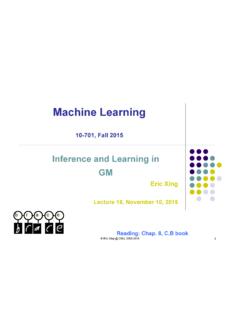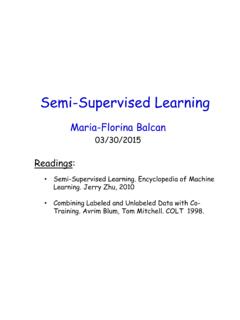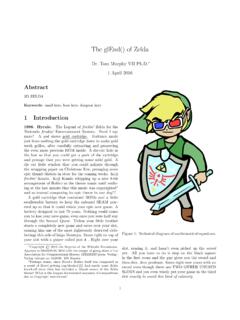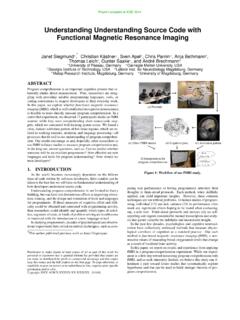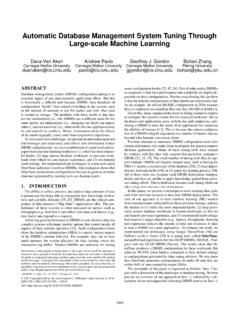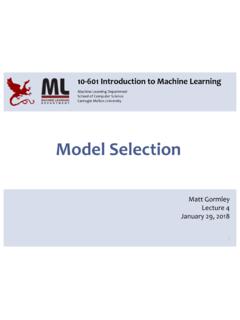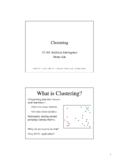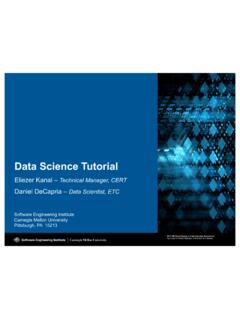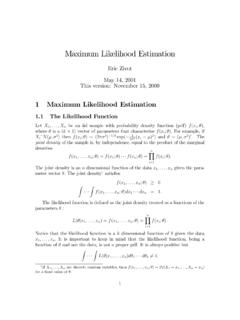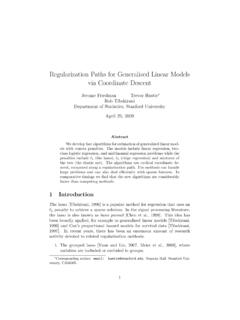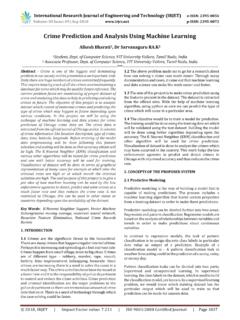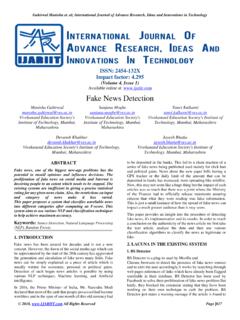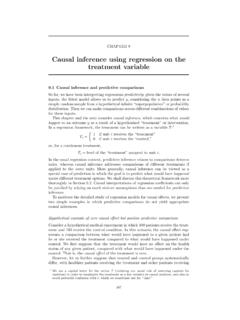Transcription of Solution of Final Exam : 10-701/15-781 Machine Learning
1 Solution of Final Exam : 10-701/15-781 Machine LearningFall 2004 Dec. 12th 2004 Your Andrew ID in capital letters:Your full name: There are 9 questions. Some of them are easy and some are more difficult. So, if you get stuck on anyone of the questions, proceed with the rest of the questions and return back at the end if you havetime remaining. The maximum score of the exam is 100 points If you need more room to work out your answer to a question, use the back of the page and clearlymark on the front of the page if we are to look at what s on the back. You should attempt to answer all of the questions.
2 You may use any and all notes, as well as the class textbook. You have 3 hours. Good luck!1 Problem 1. Assorted Questions( 16 points)(a) [ pts] Suppose we have a sample of real values, calledx1,x2, ..,xn. Each sampled from (x)which has the following form:f(x) ={ e x,if x 00,otherwise(1)where is an unknown parameter. Which one of the following expressions is the maximum likelihoodestimation of ? ( Assume that in our sample, allxiare large than 1. )1).n i=1log(xi)n2).nmaxi=1log(xi)n3).nn i=1log(xi)4).nnmaxi=1log(xi)5).n i=1xin6).nmaxi=1xin7).nn i=1xi8).nnmaxi=1xi9).n i=1x2in10).nmaxi=1x2in11).nn i=1x2i12).}
3 Nnmaxi=1x2i13).n i=1exin14).nmaxi=1exin15).nn i=1exi16).nnmaxi=1exiAnswer:Choose [7].2(b) . [ pts] Suppose thatX1, ..,Xmare categorical input attributes andYis categorical outputattribute. Suppose we plan to learn a decision tree without pruning, using the standard (True or pts) : IfXiandYare independent in the distribution that generated thisdataset, thenXiwill not appear in the decision :False (because the attribute may become relevant further down the tree when therecords are restricted to some value of another attribute) ( XOR) (True or pts) : IfIG(Y|Xi) = 0 according to the values of entropy and conditionalentropy computed from the data, thenXiwill not appear in the decision :False for same (True or pts).
4 The maximum depth of the decision tree must be less than m+1 .Answer:True because the attributes are categorical and can each be split only (True or pts) : Suppose data has R records, the maximum depth of the decision treemust be less than 1 +log2 RAnswer:False because the tree may be (True or pts) : Suppose one of the attributes has R distinct values, and it has aunique value in each record. Then the decision tree will certainly have depth 0 or 1 ( will bea single node, or else a root node directly connected to a set of leaves)Answer:True because that attribute will have perfect information gain.
5 If an attribute hasperfect information gain it must split the records into pure buckets which can be split no (c) [5 pts] Suppose you have this data set with one real-valued input and one real-valued output:xy022231( ) What is the mean squared leave one out cross validation error of using linear regression ? ( mode isy= 0+ 1x+noise)Answer:22+(2/3)2+123= 49/27( ) Suppose we use a trivial algorithm of predicting a constanty=c. What is the mean squaredleave one out error in this case? ( Assumecis learned from the non-left-out data points.) + +123= 1/24 Problem 2. Bayes Rule and Bayes Classifiers( 12 points)Suppose you are given the following set of data with three Boolean input variablesa,b,andc, and asingle Boolean output parts (a) and (b), assume we are using a naive Bayes classifier to predict the value ofKfrom thevalues of the other variables.
6 (a) [ pts] According to the naive Bayes classifier, what isP(K= 1|a= 1 b= 1 c= 0)?Answer:1 (K= 1|a= 1 b= 1 c= 0) =P(K= 1 a= 1 b= 1 c= 0)/P(a= 1 b= 1 c= 0)=P(K= 1) P(a= 1|K= 1) P(b= 1|K= 1) P(c= 0|K= 1)/P(a= 1 b= 1 c= 0 K= 1) +P(a= 1 b= 1 c= 0 K= 0).(b) [ pts] According to the naive Bayes classifier, what isP(K= 0|a= 1 b= 1)?Answer:2 (K= 0|a= 1 b= 1) =P(K= 0 a= 1 b= 1)/P(a= 1 b= 1)=P(K= 0) P(a= 1|K= 0) P(b= 1|K= 0)/P(a= 1 b= 1 K= 1) +P(a= 1 b= 1 K= 0).5 Now, suppose we are using a joint Bayes classifier to predict the value ofKfrom the values of the othervariables.(c) [ pts] According to the joint Bayes classifier, what isP(K= 1|a= 1 b= 1 c= 0)?
7 (X) be the number of records in our data matchingX. Then we haveP(K= 1|a= 1 b= 1 c= 0) =num(K= 1 a= 1 b= 1 c= 0)/num(a= 1 b= 1 c= 0) = 0/1.(d) [ pts] According to the joint Bayes classifier, what isP(K= 0|a= 1 b= 1)?Answer:1 (K= 0|a= 1 b= 1) =num(K= 0 a= 1 b= 1)/num(a= 1 b= 1) = 1 an unrelated example, imagine we have three variablesX,Y,andZ.(e) [2 pts] Imagine I tell you the following:P(Z|X) = (Z|Y) = you have enough information to computeP(Z|X Y)? If not, write not enough info . If so,compute the value ofP(Z|X Y) from the above :Not enough (f) [2 pts] Instead, imagine I tell you the following:P(Z|X) = (Z|Y) = (X) = (Y) = you now have enough information to computeP(Z|X Y)?
8 If not, write not enough info . If so,compute the value ofP(Z|X Y) from the above :Not enough info.(g) [2 pts] Instead, imagine I tell you the following (falsifying my earlier statements):P(Z X) = (X) = (Y) = 1Do you now have enough information to computeP(Z|X Y)? If not, write not enough info . If so,compute the value ofP(Z|X Y) from the above :2 (Z|X Y) =P(Z|X) sinceP(Y) = 1. In this case,P(Z|X Y) =P(Z X)/P(X) = = 2 3. SVM( 9 points)(a) (True/False-1 pt) support vector machines, like logistic regression models, give a probabilitydistribution over the possible labels given an input :False(b) (True/False-1 pt) We would expect the support vectors to remain the same in general as we movefrom a linear kernel to higher order polynomial :False ( There are no guarantees that the support vectors remain the same.)
9 The feature vectorscorresponding to polynomial kernels are non- linear functions of the original input vectors and thus thesupport points for maximum margin separation in the feature space can be quite different. )(c) (True/False-1 pt) The maximum margin decision boundaries that support vector machinesconstruct have the lowest generalization error among all linear :False ( The maximum margin hyperplane is often a reasonable choice but it is by no meansoptimal in all cases. )(d) (True/False-1 pt) Any decision boundary that we get from a generative model with class-conditional Gaussian distributions could in principle be reproduced with an SVM and a polynomial kernelof degree less than or equal to :True (A polynomial kernel of degree two suffices to represent any quadratic decision boundarysuch as the one from the generative model in question.
10 8(e) (True/False-1 pts) The values of the margins obtained by two different kernelsK1(x,x0) andK2(x,x0) on the same training set do not tell us which classifier will perform better on the test :True ( We need to normalize the margin for it to be meaningful. For example, a simple scalingof the feature vectors would lead to a larger margin. Such a scaling does not change the decision boundary,however, and so the larger margin cannot directly inform us about generalization. )(f) (2 pts) What is the leave-one-out cross-validation error estimate for maximum margin separationin the following figure ?
